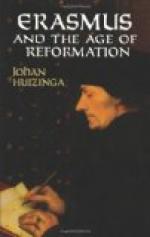From Paris he wrote to Colet to report progress, saying that he had learnt Greek and was ready to turn to the Scriptures, and asking him to interest English patrons in their common work. By this time Colet himself had become a patron, having been appointed Dean of St. Paul’s. It is therefore not surprising to find that within a year Erasmus was established in London, living in a bishop’s house, endowed by his old pupil Lord Mountjoy, and rejoicing in the society of the learned friends gathered in the capital. Chief among these was Colet, who lent him manuscripts from the Chapter Library of St. Paul’s, and provided a copyist to write out the fruits of his labours, a one-eyed Brabantine, Peter Meghen by name, who acted also as Colet’s private letter-carrier. Meghen wrote a bold, well-marked hand, which is easily recognizable, and in consequence his work has been traced in many libraries. The British Museum has a treatise of Chrysostom, translated by Selling, and written by Meghen for Urswick, afterwards Dean of Windsor and Rector of Hackney, to present to Prior Goldstone of Canterbury. (Urswick was frequently sent on embassies, and had doubtless enjoyed the hospitality of Christchurch on his way between London and Dover.) At Wells there are a Psalter and a translation of Chrysostom on St. Matthew, which Urswick, as executor to Sir John Huddelston, knight, caused Meghen to write in 1514 for presentation to the Cistercians of Hailes, in Gloucestershire. The Bodleian has a treatise written by him in 1528 for Nicholas Kratzer to present to Henry VIII; and Wolsey’s Lectionary at Christ Church, Oxford, is probably in Meghen’s hand.
But what concern us here are some manuscripts in the British Museum and the University Library at Cambridge, written by Meghen in 1506 and 1509 at Colet’s order for presentation to his father, Sir Henry Colet, Lord Mayor of London, and containing in parallel columns the Vulgate and another Latin translation of the New Testament, ’per D. Erasmum Roterodamum’. Part and possibly all of this work was done by Erasmus, therefore, during this second residence in England in 1505-6. He tells us that he received two Latin manuscripts from Colet, which he found exceedingly difficult to decipher; but one cannot make a new translation from the Latin. To the Greek manuscripts used on this occasion he gives no clue.
In connexion with this help and encouragement shown by Colet as Dean to a foreign scholar, it is worth while to mention the visit to London in 1509 of Cornelius Agrippa, the famous philosopher and scientist, who had been sent to England by Maximilian on a diplomatic errand, which he describes as ‘a very secret business’. During his stay, which lasted into 1510, he tells us that ’I laboured much over the Epistles of St. Paul, in the company of John Colet, a man most learned in Catholic doctrine, and of the purest life; and from him I learnt many things that I did not know’. Erasmus was in England




